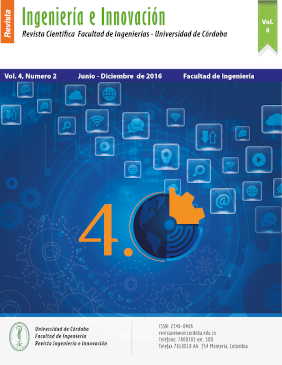Modelo multi-agente para la evaluación y el diagnóstico de fallas en procesos de enseñanza-aprendizaje
Modelo multi-agente para la evaluación y el diagnóstico de fallas en procesos de enseñanza-aprendizaje
Show authors biography
En los ambientes virtuales de aprendizaje no existen actualmente mecanismos efectivos que permitan una detección temprana y diagnóstico de fallas en el aprendizaje. Integrar este tipo de elementos a los entornos virtuales de aprendizaje, podría mejorar el aprendizaje ya que a partir del diagnóstico suministrado por el sistema se puede diseñar un plan de acciones que contribuya al fortalecimiento de las temáticas de los cursos. El objetivo de este artículo es presentar el diseño y desarrollo de un modelo multi-agente para la evaluación y el diagnóstico de fallas el cual busca descubrir las falencias en el aprendizaje a partir del proceso de evaluación virtual. Adicionalmente, el modelo busca ofrecer una retroalimentación y recomendar nuevos contenidos educativos adaptados a los perfiles de los aprendices. Basado en el modelo propuesto, un prototipo fue implementado y validado a través de un caso de estudio. Los resultados obtenidos permiten concluir que los estudiantes se sintieron acompañados durante el proceso de evaluación y obtuvieron una retroalimentación en tiempo real que identificó falencias y permitió recomendar recursos educativos con el fin de fortalecer el proceso de aprendizaje.
Article visits 545 | PDF visits
Downloads
- . M. Amelung, K. Krieger, and D. Rosner, “E-Assessment as a Service,” IEEE Trans. Learn. Technol., vol. 4, no. 2, pp. 162–174, Apr. 2011.
- . N. Mora, S. Caballe, and T. Daradoumis, “Improving e-Assessment in Collaborative and Social Learning Settings,” in 2015 International Conference on Intelligent Networking and Collaborative Systems, 2015, pp. 288– 293.
- . P. Thomas, D. Haley, A. deRoeck, and M. Petre, “e-assessment using latent semantic analysis in the computer science domain: a pilot study,” pp. 38–44, Aug. 2004.
- . N. D. Duque and D. A. Ovalle, “ARTIFICIAL
- . INTELLIGENCE PLANNING TECHNIQUES FOR ADAPTIVE VIRTUAL COURSE CONSTRUCTION,” DYNA, vol. 78, no. 170, pp. 70–78, 2011.
- . P. Raju and V. Ahmed, “Enabling technologies for developing next-generation learning object repository for construction,” Autom. Constr., vol. 22, pp. 247–257, Mar. 2012.
- . J. Tramullas, A.-I. Sánchez-Casabón, and P. Garrido- Picazo, “An Evaluation based on the Digital Library user: An Experience with Greenstone Software,” Procedia - Soc. Behav. Sci., vol. 73, pp. 167–174, Feb. 2013.
- . R. Scarlat, L. Stanescu, E. Popescu, and D. D. Burdescu,Case-Based Medical E-assessment System,” in 2010 10th IEEE International Conference on Advanced Learning Technologies, 2010, pp. 158–162.
- . F. Hajjej, Y. B. Hlaoui, and L. J. Ben Ayed, “Personalized and Generic E-assessment Process Based on Cloud Computing,” in 2015 IEEE 39th Annual Computer Software and Applications Conference, 2015, vol. 3, pp. 387–392.
- . S. Ahmad and M. Bokhari, “A New Approach to Multi Agent Based Architecture for Secure and Effective E-learning,” Int. J. Comput. Appl., vol. 46, no. 22, pp. 26–29, 2012.
- . P. Lin, J. Thangarajah, and M. Winikoff, “The Prometheus Design Tool (PDT) supports the structured design of intelligent agent systems,” in Proceedings of the 23rd national conference on Artificial intelligence - Volume 3, 2008, pp. 1884–1885.
- . Á. Carrera, C. A. Iglesias, J. García-Algarra, and D. Kolařík, “A real-life application of multi-agent systems for fault diagnosis in the provision of an Internet business service,” J. Netw. Comput. Appl., vol. 37, pp. 146–154, Jan. 2014.
- . O. Salazar, D. Ovalle, and N. Duque, “Adaptive and Personalized Educational Ubiquitous Multi-Agent System Using Context-Awareness Services and Mobile Devices,” in Second International Conference, LCT 2015, Held as Part of HCI International 2015, Los Angeles, CA, USA, August 2-7, 2015, Proceedings, 2015, pp. 301–312.
- . F.L. Bellifemine, G. Caire, D. Greenwood, “Developing Multi-Agent Systems with JADE”, Vol. 7, pp. 281, John Wiley & Sons Editorial, 2007.
- . R.H. Bordini, L. Braubach, M. Dastani, A.E.F. Seghrouchni, J.J. Gómez-Sanz, J. Leite, G. O’Hare, A. Pokahr, A. Ricci, “A Survey of Programming Languages and Platforms for Multi-Agent Systems”. Revista Informatica, Vol. 30, pp. 33–44, 2006.
- . T. D. Allen, K. M. Shockley, and L. Poteat, “Protégé anxiety attachment and feedback in mentoring relationships,” J. Vocat. Behav., vol. 77, no. 1, pp. 73–80, Aug. 2010.
- . G. Meditskos and N. Bassiliades, “A Rule-Based Object-Oriented OWL Reasoner,” IEEE Trans. Knowl. Data Eng., vol. 20, no. 3, pp. 397–410, 2008.
- . B. McBride, “Jena: a semantic Web toolkit,” IEEE Internet Comput., vol. 6,




